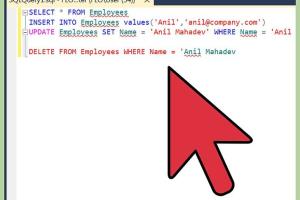Mastering Basic SQL Statements in SQL Server: A Comprehensive Guide

-
Quick Links:
- 1. Introduction to SQL Server
- 2. What is SQL?
- 3. Basic SQL Statements
- 4. SQL Clauses
- 5. Case Studies and Examples
- 6. Step-by-Step Guide to Writing SQL Statements
- 7. FAQs
1. Introduction to SQL Server
SQL Server is a relational database management system developed by Microsoft that supports a wide variety of transaction processing, business intelligence, and analytics applications. It allows for the management of structured data through the use of SQL (Structured Query Language).
2. What is SQL?
SQL, which stands for Structured Query Language, is a standard programming language specifically for managing and manipulating relational databases. It provides powerful capabilities for performing tasks such as querying data, updating records, and managing database structures.
3. Basic SQL Statements
Basic SQL statements are the foundation of database management. Understanding these statements is crucial for anyone looking to interact with SQL Server effectively. Below are the primary SQL statements that every beginner should know.
3.1 SELECT Statement
The SELECT statement is used to query data from a database. Here is the syntax:
SELECT column1, column2 FROM table_name WHERE condition;You can select all columns by using asterisk *:
SELECT * FROM table_name;Example:
SELECT first_name, last_name FROM employees;3.2 INSERT Statement
The INSERT statement is used to add new records to a table:
INSERT INTO table_name (column1, column2) VALUES (value1, value2);Example:
INSERT INTO employees (first_name, last_name) VALUES ('John', 'Doe');3.3 UPDATE Statement
The UPDATE statement modifies existing records in a table:
UPDATE table_name SET column1 = value1 WHERE condition;Example:
UPDATE employees SET last_name = 'Smith' WHERE first_name = 'John';3.4 DELETE Statement
The DELETE statement removes records from a table:
DELETE FROM table_name WHERE condition;Example:
DELETE FROM employees WHERE last_name = 'Smith';4. SQL Clauses
SQL clauses are used to filter, sort, and group data. Here are the most commonly used clauses.
4.1 WHERE Clause
The WHERE clause is used to filter records:
SELECT * FROM table_name WHERE condition;4.2 ORDER BY Clause
The ORDER BY clause sorts the result set in either ascending or descending order:
SELECT * FROM table_name ORDER BY column1 ASC|DESC;4.3 GROUP BY Clause
The GROUP BY clause groups rows that have the same values in specified columns into summary rows:
SELECT column1, COUNT(*) FROM table_name GROUP BY column1;5. Case Studies and Examples
Understanding SQL through real-world cases can be incredibly beneficial. Let's explore a few examples:
Case Study 1: Employee Database
In an employee database, you might want to find the average salary of employees in each department. You can do this using the following SQL statement:
SELECT department, AVG(salary) FROM employees GROUP BY department;Case Study 2: Sales Data Analysis
For a sales database, you might want to find the total sales per region:
SELECT region, SUM(sales) FROM sales_data GROUP BY region;6. Step-by-Step Guide to Writing SQL Statements
Here are the steps to create SQL statements effectively:
- Identify the data you want to retrieve or manipulate.
- Choose the appropriate SQL statement (SELECT, INSERT, UPDATE, DELETE).
- Define the necessary clauses (WHERE, ORDER BY, GROUP BY).
- Test your SQL statement to ensure it performs as expected.
- Optimize your query for efficiency.
7. FAQs
1. What is SQL Server?
SQL Server is a relational database management system developed by Microsoft that allows users to store and manage data.
2. How do I connect to SQL Server?
You can connect using SQL Server Management Studio (SSMS) or through applications that support SQL Server connections.
3. What is a primary key?
A primary key is a unique identifier for a record in a database table, ensuring that no two records have the same value.
4. What is normalization?
Normalization is the process of organizing data in a database to reduce redundancy and improve data integrity.
5. What is a foreign key?
A foreign key is a field in one table that uniquely identifies a row of another table, establishing a link between the two tables.
6. How can I retrieve unique records?
You can retrieve unique records using the SELECT DISTINCT statement.
7. What is an aggregate function?
Aggregate functions perform a calculation on a set of values and return a single value, such as COUNT, SUM, AVG, etc.
8. How do I use multiple conditions in a WHERE clause?
You can use AND and OR operators to combine multiple conditions in a WHERE clause.
9. Can I join multiple tables?
Yes, you can join multiple tables using INNER JOIN, LEFT JOIN, RIGHT JOIN, and FULL JOIN statements.
10. How can I backup my SQL Server database?
You can back up your database using SQL Server Management Studio or by executing a backup command.
Conclusion
Mastering basic SQL statements in SQL Server is essential for anyone looking to manage and manipulate data efficiently. With practice and a solid understanding of these concepts, you can leverage SQL to its fullest potential.
External References
Random Reads
- How to install a motherboard
- Easy guide to using gps
- Easy steps to be a vlogger
- How to unlock disabled ipod
- How to unlock factions in rome total war
- How to change default font windows 7
- How to age brass antique look
- How to advertise a garage sale on craigslist
- How to upgrade ice staff cod bo2
- How to upgrade a laptop replace parts